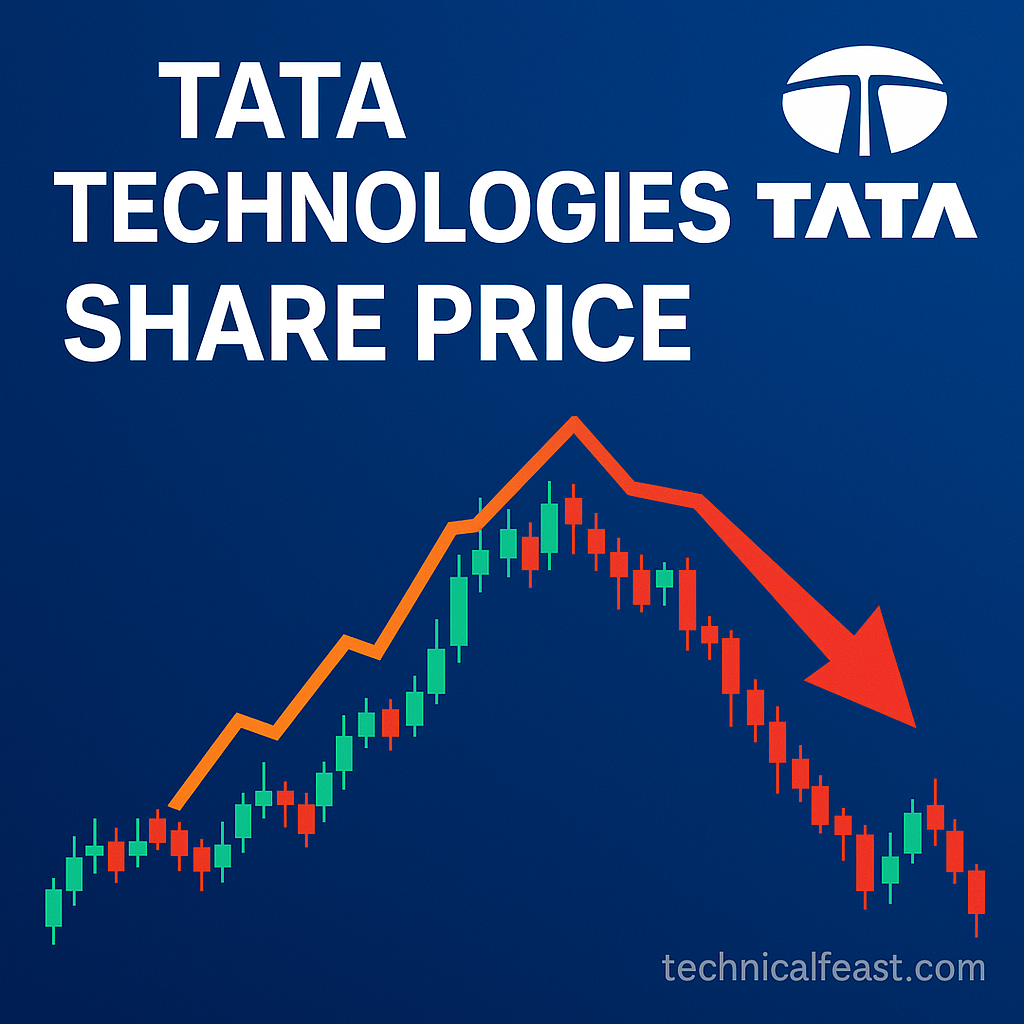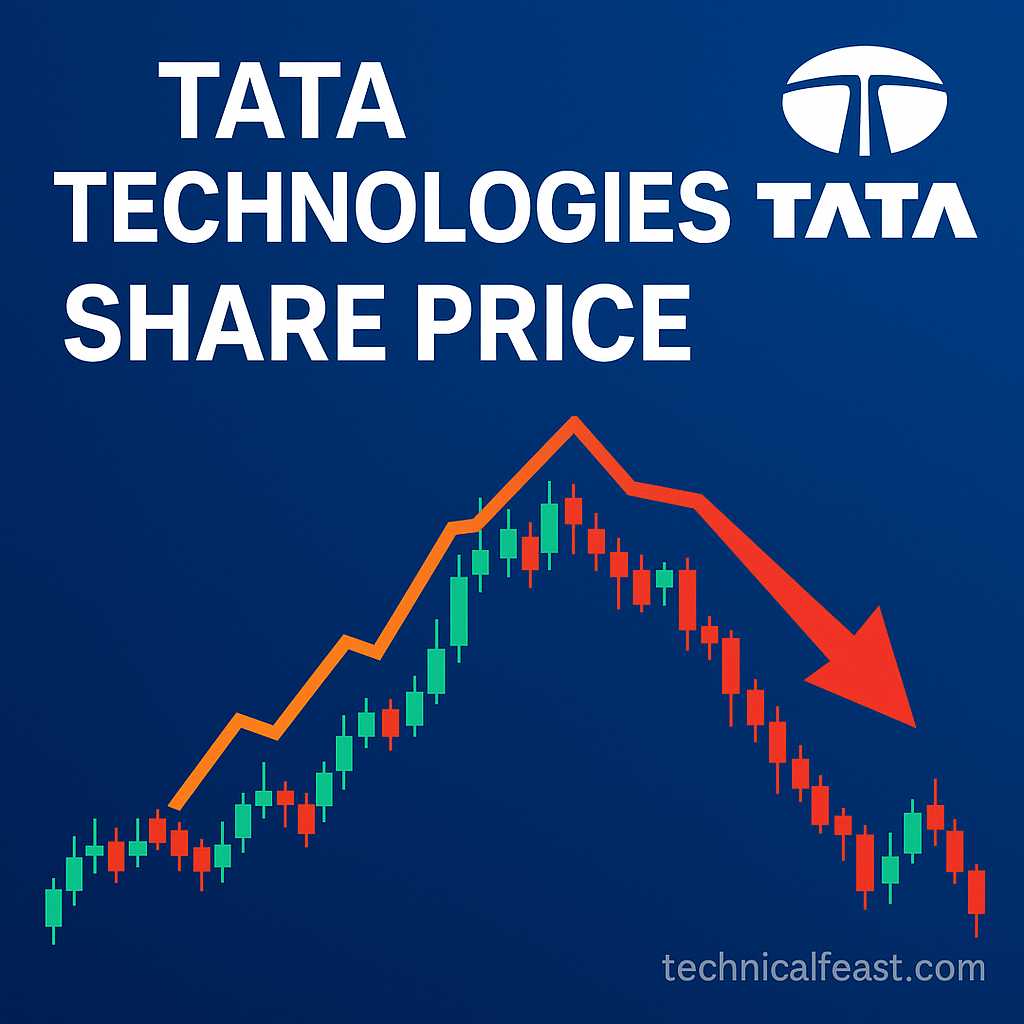In late 2023, Tata Technologies made a splash on Dalal Street with a blockbuster stock market debut. The engineering services firm’s initial public offering (IPO) was the first Tata Group listing in 19 years (since TCS in 2004)
goodreturns.in, and investor enthusiasm ran high. On listing day (November 30, 2023), Tata Technologies shares doubled investors’ wealth – opening around ₹1,200, which was about a 140% premium over its ₹500 issue price
businesstoday.in. The stock even touched intraday highs near ₹1,400 amid euphoria
livemint.com. This stellar debut immediately valued the company at nearly ₹48,700 crore (about $6 billion) on day one
businesstoday.in. However, fast forward to 2025, and the share price now tells a more tempered tale as the market strives to find a fair value for this Tata offshoot.
Current Share Price and Recent Performance Trends
As of April 2025, Tata Technologies’ stock is trading around ₹649 per share, after the markets closed on April 4, 2025
economictimes.indiatimes.com. This current price marks a steep comedown from the post-IPO highs. In fact, the stock is now roughly half of its peak levels seen during the frenzied debut – a peak which approached ~₹1,148 within its first weeks
economictimes.indiatimes.com. At the same time, today’s price remains higher than the IPO issue price, meaning early allottees at ₹500 still sit on about a 30% gain on paper. The past year has essentially been a round trip from euphoria to reality: in the last 52 weeks Tata Tech’s share has swung from a high of ₹1,147.75 down to a low of ₹626.65

economictimes.indiatimes.com. The current value near ₹649 is barely above that historic low, indicating the stock has given up most of its initial gains.
The recent performance trend has been largely downward. Over the last three months alone, Tata Technologies’ share price has slid nearly 28%
economictimes.indiatimes.com. For instance, the stock fell from the ₹800–₹850 levels in January 2025 to the ₹600–₹650 range by early April. It has also underperformed many large-cap peers in the same period. Short-term bounces have occurred – in fact, optimism ahead of its Q3 FY25 earnings briefly lifted the stock to about ₹841 in late January
business-standard.com – but such gains didn’t hold for long. By and large, since October 2024 the stock has been in a corrective phase
livemint.com, with each rally met by profit-taking. The result is a share price that, while still reflecting Tata Technologies’ solid business foundation, has been tempered by market reality after the initial hype.
Background: What Does Tata Technologies Do?
To understand the stock’s journey, it helps to know the company behind it. Tata Technologies Limited is a global engineering and product development digital services company headquartered in Pune, India
en.wikipedia.org. Founded in 1989 as an automotive design division of Tata Motors, it was spun off as a separate company in 1994
en.wikipedia.org. Tata Motors remains the majority owner (holding roughly 53% stake post-IPO)
en.wikipedia.org, which means Tata Technologies is a subsidiary of the Tata Motors automotive group. This heritage gave investors confidence during the IPO – the Tata brand is associated with trust – and also positions Tata Technologies with a built-in relationship to a major automaker.
Tata Technologies’ business focus is on product engineering and design services, primarily for the automotive and aerospace industries
en.wikipedia.org. In practice, it helps automakers and industrial manufacturers design and develop new products – for example, by providing engineering research & development (ER&D), digital design, and product lifecycle management services. The company has a global footprint with delivery centers in India, North America (notably Detroit), Europe, and Asia-Pacific, employing over 11,000 people as of 2023
en.wikipedia.org. Its clients include leading original equipment manufacturers (OEMs) in the auto and aerospace sectors. This niche – engineering R&D outsourcing – is a high-value segment riding trends like electric vehicles (EVs), autonomous driving tech, and Industry 4.0. In FY2024, Tata Technologies generated revenues of about ₹5,233 crore (≈$610 million) and a net profit of ₹727 crore
en.wikipedia.org, making it a mid-sized but profitable player in India’s tech landscape. This context is important: the IPO optimism was partly driven by the company’s solid financials and its role in the fast-evolving mobility and manufacturing tech space.
Key Factors Influencing Tata Tech’s Share Price
Several factors have been driving the movement of Tata Technologies’ stock since its listing. The share price’s rise and fall can be traced to a mix of the company’s financial performance, market sentiment shifts, and industry news. Below are the key elements influencing Tata Tech’s stock trajectory:
- Financial Results and Growth: Tata Technologies’ recent earnings have been lukewarm, which has weighed on the stock. The company saw its profit dip slightly for three consecutive quarters through 2024business-standard.com. For instance, in Q2 FY25 (July–September 2024), consolidated profit after tax fell about 2% YoY to ₹157 crorebusiness-standard.com – marking the third straight quarter of year-over-year profit decline – even as revenue inched up only 2%business-standard.com. Similarly, the latest Q3 FY25 results (Oct–Dec 2024) showed net profit essentially flat (down just 1% YoY at ₹169 crore) despite a modest 2.2% rise in revenuelivemint.com. Such slow growth in earnings has tempered investor expectations, especially considering the lofty valuations the stock enjoyed at debut. When a newly listed company doesn’t deliver rapid growth to justify its price, the market often reacts by re-rating the stock lower.
- Market Sentiment and Valuation: The market mood around Tata Tech shifted from exuberance to caution in the months after listing. Early on, excitement about the Tata lineage and the company’s niche drove the stock to extreme valuations – at one point the stock traded at a price-to-earnings (P/E) ratio well above 80 based on its earnings, far higher than most established tech peers. This prompted many investors to book profits after the IPO pop, a natural reaction when a stock doubles and then some. As initial euphoria cooled, the realization set in that Tata Tech, while strong, is a mid-cap engineering firm facing normal business cycles. Even at the current ₹650 level, the stock trades around 40 times its earningsscreener.in, which is still rich compared to larger IT companies like TCS or Infosys that trade in the 20–30 P/E range. Such a high valuation means the bar is set high for Tata Tech’s future performance. The combination of profit-taking and valuation concerns has been a major factor in the share price drifting down from its peaks. Moreover, towards late 2024, broader stock market dynamics (such as a rotation from expensive growth stocks to value picks and some year-end selling when pre-IPO lock-in periods expired) also dampened sentiment on Tata Tech’s stock.
- Industry Trends – EV Slowdown: A significant external factor has been the global slowdown in electric vehicle demand and tech spending, which directly impacted Tata Technologies’ business. Many of Tata Tech’s automotive clients, including those in the EV space, moderated their R&D spending amid economic uncertainties in 2024. The company itself noted that a slowdown in global EV investments was a headwind, contributing to the recent dip in profitsbusiness-standard.com. In other words, the rapid growth that investors hoped for in areas like electric mobility has been delayed. This industry trend hurt not only Tata Tech but also similar companies riding the EV wave. (For perspective, KPIT Technologies, another automotive engineering firm, saw its share price fall from a ₹1,928 high to about ₹1,115 over the past yearmoneycontrol.com, reflecting a broader cooling off in the segment.) The market has taken note that Tata Tech’s fortunes are tied to cyclical automotive and aerospace sectors; when those sectors slow down, so can Tata Tech’s growth. Consequently, any news of slumping car demand, chip shortages, or global economic jitters has tended to make investors more cautious about this stock.
- News and Developments: On the positive side, Tata Technologies has been making strategic moves that could influence future performance. The company has bagged new contracts and formed partnerships aimed at emerging opportunities. For example, it secured four large deals in Q3 FY25 and reported a healthy project pipeline, according to its managementlivemint.com. One headline-grabbing development was Tata Tech’s partnership with Telechips, a Korean automotive semiconductor firm, announced in January 2025. This collaboration is focused on developing software solutions for next-generation software-defined vehicles – essentially the brains of future electric and autonomous carsbusiness-standard.com. Such partnerships signal Tata Tech’s intent to stay at the cutting edge of automotive tech, from advanced driver-assistance systems (ADAS) to connected car platforms. While these news pieces have not immediately reversed the stock’s decline, they add a story of innovation and long-term growth potential that investors are keeping in mind. In short, positive developments like new deals, partnerships, and expansion into high-tech domains provide a counterbalance to near-term concerns, and any significant announcements in these areas can buoy market sentiment.
Sector Performance and Peer Comparison

It also helps to compare Tata Technologies’ stock performance with the broader IT and engineering sector to put things in perspective. The Indian IT services index and large-cap tech stocks have had a more stable run compared to Tata Tech’s roller-coaster. Established peers like Tata Consultancy Services (TCS) and Infosys – though not direct competitors in product engineering, they are bellwethers of the tech sector – saw relatively modest share price moves in the same timeframe. These giants grappled with their own challenges (like a global IT spending slowdown) but generally traded in a steady range with single-digit percentage changes. Their maturity and diversified client base meant less drama for their stock prices. By contrast, Tata Technologies, being a newly listed mid-cap stock, experienced far more volatility as the market tried to price in its growth prospects. The initial premium valuations (Tata Tech’s P/E was ~40+ vs. ~25 for TCS
screener.in) highlighted that investors were pricing in faster growth for Tata Tech – a projection that is now being re-evaluated.
When looking at other mid-sized engineering and tech companies, a similar pattern emerges. We already noted KPIT Technologies’ sharp swings tied to the electric/autonomous vehicle theme. Another comparable firm is L&T Technology Services (LTTS), an engineering R&D services company, which also went through phases of high valuation and subsequent correction in recent years. In late 2023 and early 2024, many specialty tech stocks in India surged on optimism for digital and EV-related businesses, only to cool off as realities like rising interest rates and global tech cuts hit. Tata Technologies’ stock has essentially followed this mid-cap tech playbook: a big surge, followed by a sizable correction. The key difference is that Tata Tech had its surge right at listing due to IPO excitement, whereas others built up over time. In terms of sector performance, the Nifty IT index (tracking major Indian tech stocks) had its ups and downs but did not see a 50% swing like Tata Tech did – again underscoring the unique situation of Tata Tech’s post-listing revaluation.
Notably, investors often compare Tata Technologies with its peers on growth metrics. Tata Tech’s revenue growth of ~2% and profit decline in recent quarters lagged some competitors; for example, KPIT grew profits ~20% YoY in late 2024
tickertape.in and LTTS managed steady growth in its segments. On the other hand, Tata Tech boasts a strong return on capital (ROCE ~28%
screener.in) and a debt-free balance sheet, which is comparable to or better than peers – indicating operational strength. In summary, Tata Technologies has been moving largely in sync with sector trends, but with amplified swings. When the tech sector is in favor, Tata Tech tends to outperform (thanks to its focused niche and lower base), and when the sector sentiments sour, Tata Tech’s stock is hit disproportionately harder. This high-beta behavior is common for mid-cap stocks in emerging tech areas.
A Story of Hype and Reality
The journey of Tata Technologies’ share price tells a story that many investors can relate to. Early on, it was a story of hype, hope, and the thrill of quick gains. Imagine an investor who was lucky enough to get an allotment in the IPO or even one who jumped in on listing day – their investment doubled in value almost overnight. That kind of debut created a buzz across the market, and Tata Tech became a household name among Indian retail investors in late 2023. The Tata brand trust and the company’s futuristic business in EV and aerospace engineering added to the allure. It was easy to get carried away by headlines of “wealth doubled” and the prospect that this could be the next star of the Tata empire.

However, as the months rolled on, the narrative shifted to one of market reality and lessons learned. Those who bought at the peak saw the stock steadily decline, testing their conviction. The decline was not due to any scandal or major failure, but the simple fact that business growth takes time and rarely follows the straight-up trajectory that hype suggests. Tata Technologies continued to be a fundamentally sound company, but the expectations were sky-high after the IPO. When quarterly results came in just good and not great, the market reacted by pulling the stock price down from the clouds. For long-term investors, this has been a reminder that even strong companies can have volatile stock movements. One could say Tata Tech’s stock went from being a high-flying “rocket” to a more grounded aircraft – still on a journey, but cruising at a more realistic altitude.
Throughout this period, Tata Technologies’ management has emphasized the long game. They highlight how the company is building capabilities in areas like digital engineering, smart manufacturing, and even artificial intelligence to drive future growth
livemint.com. The CEO, Warren Harris, expressed “measured optimism” for the coming quarters, citing a healthy deal pipeline and investments in new technologies
livemint.com. In the story arc of the stock, we are likely past the initial climax of the IPO pop and in the phase where the company must prove its worth through execution. It’s an ongoing narrative: as Tata Technologies secures new projects (say, helping an automaker design its next electric car platform) or as the EV market picks up again, the stock could find a new footing. Conversely, if global headwinds persist, the stock might stay subdued. For the general public watching this story, the takeaway is that a great company isn’t always a great stock in the short term – but over the long term, fundamentals tend to shine through the noise.
Summary
- Current Share Price: Tata Technologies is trading around ₹650 per share in April 2025, which is well below its peak post-IPO price but still above the IPO issue price of ₹500livemint.com. The stock has seesawed from about ₹1,148 at its 52-week high to roughly ₹627 at the loweconomictimes.indiatimes.com, reflecting significant volatility.
- Recent Performance: After a spectacular IPO debut (shares listed at ₹1,200, a 140% premiumbusinesstoday.in), the stock’s trend turned downward. It has declined about 25–30% in the last few months aloneeconomictimes.indiatimes.com, underperforming broader markets. Occasional rallies (for example, ahead of earnings) have been short-lived amid an overall corrective phase.
- Key Influences: The stock’s movement has been driven by moderate financial results, shifts in market sentiment, and industry developments. Tata Tech’s profits saw marginal declines in recent quarters despite slight revenue growthlivemint.com, which cooled investor optimism. A global EV sector slowdown hurt client spending and dampened growthbusiness-standard.com. Additionally, after the IPO euphoria, rich valuations led to profit-booking; even now the stock’s valuation is relatively high, demanding stronger performance to support it. On the other hand, positive news like new project wins and partnerships (e.g. in next-gen vehicle software) have provided silver linings and potential long-term catalystsbusiness-standard.comlivemint.com.
- Company Context: Tata Technologies is a Tata Motors subsidiary offering engineering R&D services to auto, aerospace, and manufacturing companiesen.wikipedia.org. It’s a mid-cap tech firm (~₹26,000 crore market capscreener.in) with solid fundamentals – profitable, debt-free, and focused on high-growth areas like electric and autonomous vehicles. However, it operates in cyclical industries, so its fortunes ebb and flow with global trends.
- Peer Comparison: Compared to sector peers, Tata Tech’s stock has been more volatile. Large-cap IT stocks (TCS, Infosys) were relatively stable, whereas mid-cap peers in automotive tech (e.g. KPIT) also saw big swings, indicating a broader trendmoneycontrol.com. Tata Tech’s valuation multiples are higher than older peers, highlighting both its growth potential and the market’s higher risk-reward stance on it.
In conclusion, Tata Technologies’ share price story has been one of initial exhilaration followed by a reality check. The current share price reflects a more realistic appraisal of the company’s steady (if not explosive) growth and the challenges in its industry. For observers and shareholders, the company remains an interesting player at the intersection of India’s tech and automotive sectors. Going forward, all eyes will be on how Tata Technologies leverages its Tata lineage, engineering expertise, and new partnerships to accelerate growth – because sustained financial performance will ultimately determine whether this stock can script a new rally or continues cruising at its current altitude.
Sources:
- Tata Technologies stock quote and market data – Economic Timeseconomictimes.indiatimes.comeconomictimes.indiatimes.comeconomictimes.indiatimes.com
- IPO listing premium and initial surge – Business Todaybusinesstoday.in; Livemintlivemint.com; Goodreturnsgoodreturns.ingoodreturns.in
- Recent share price performance and IPO vs current comparison – Livemintlivemint.comlivemint.com
- Financial results (Q2 & Q3 FY25) and profit slowdown – Business Standardbusiness-standard.com; Livemintlivemint.com
- Industry and EV demand impact – Business Standardbusiness-standard.com
- Telechips partnership and new deals – Business Standardbusiness-standard.com; Economic Times (PTI)m.economictimes.com
- Tata Technologies company background – Wikipediaen.wikipedia.orgen.wikipedia.orgen.wikipedia.org
- Peer stock performance (KPIT Technologies) – Moneycontrol datamoneycontrol.com and sector P/E contextscreener.in




Leave a Reply